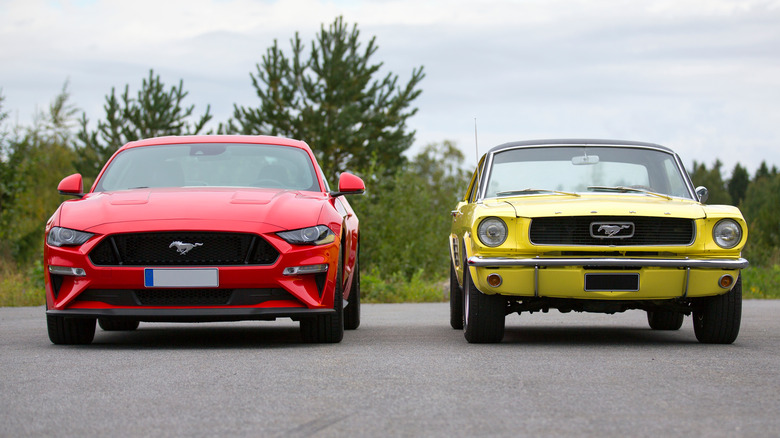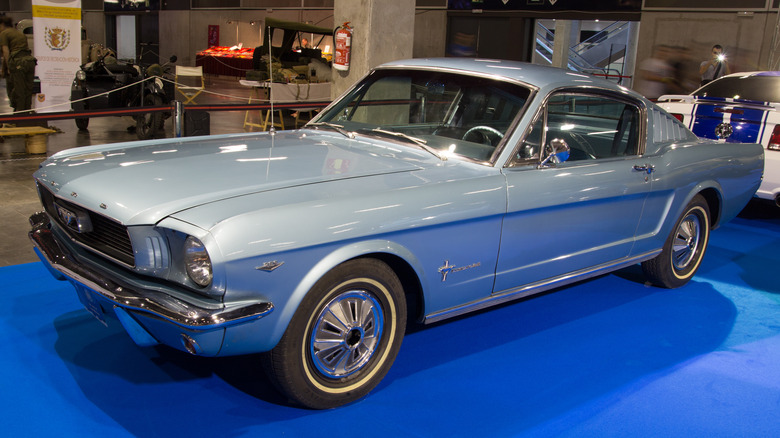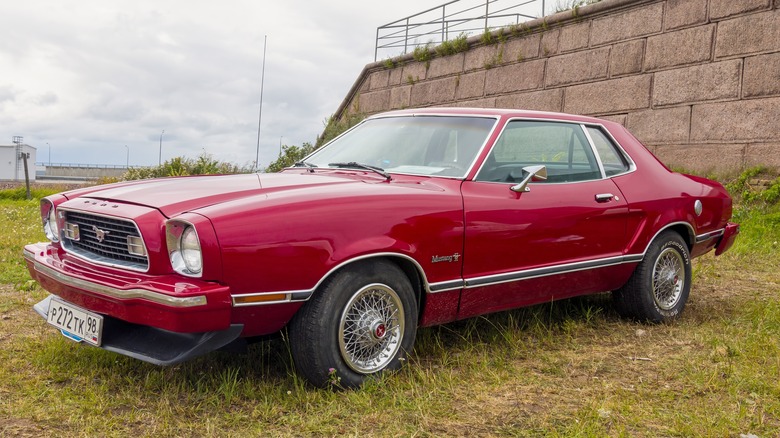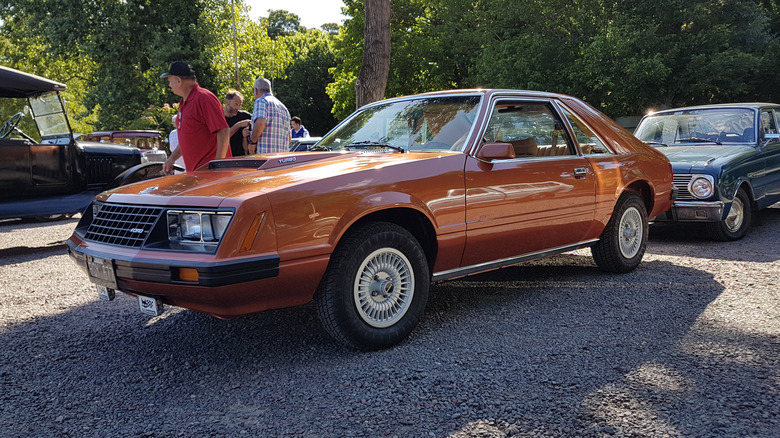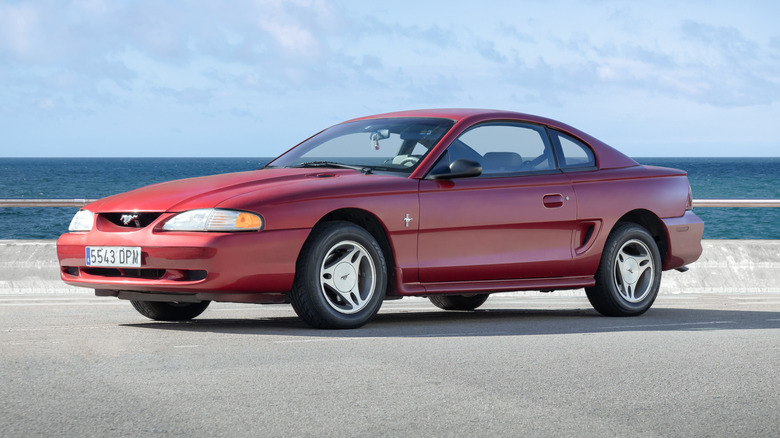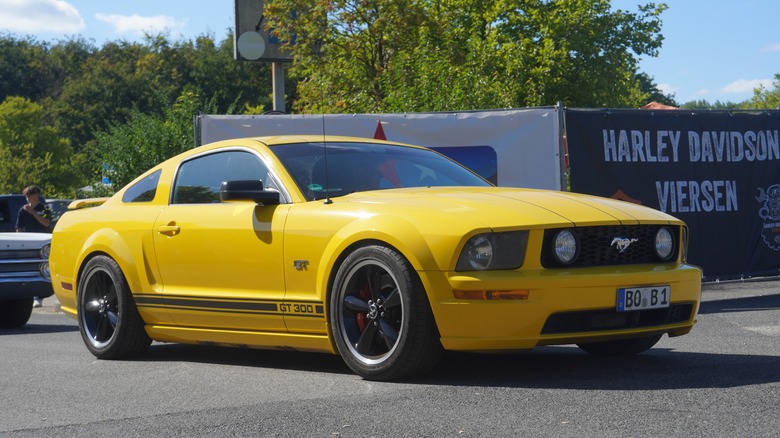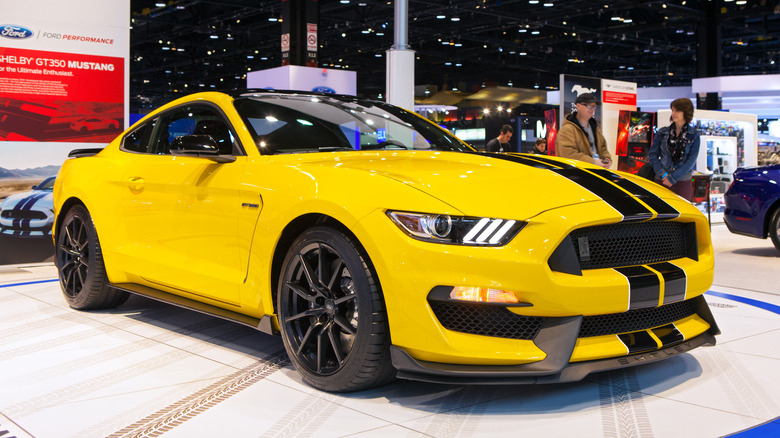The Ford Mustang: Every Generation Of The Iconic Pony Car Explained
When Henry Ford introduced the Model T, he set his company on a course that would have transformative effects on not just the automotive industry, but also on society at large. The proliferation of the automobile put people on the move and allowed the transition from the era of industrial expansion to one of technological expansion. In many ways, the automobile is the cornerstone of modern life.
Many years later, Ford gave us another automobile that brought on a softer revolution in travel. This was not a transformational change in society, but a change in how we view the purpose of the car. Cars had long been used for their utilitarian purpose, as well as for pleasure driving. However, there long seemed to be a fairly strong divide between a sporting, fast car, and one to be used for everyday purposes. If you wanted one, you were denied the other. When Ford brought us the 1964 ½ Mustang, it changed perceptions by bringing fun in a practical and affordable package. The Mustang could be used on the track on the weekends, and still be appropriate for dropping the kids off at school on Monday. The Mustang established an all-new category of car known as the "pony car."
After selling millions of Mustangs, Ford is forging ahead with the pony car, and sales remain strong. It is one of the most recognizable vehicles on the planet, and most Americans have ridden in a Mustang at some time in their lives. As we look forward to the unveiling of the next generation of Mustang, let's look back at what got us to this point.
Gen 1 1965-1973: The Original Pony car
The idea for the Mustang was championed by the legendary Lee Iacocca, who saw an opportunity for a fun and practical car to be marketed to younger buyers (via NBC News). The Mustang was part of a broader response from American manufacturers to counter the rising sales of imported cars from Europe. Ford had already introduced the Falcon to this end and it served as the basis for Iacocca's new car. Ford then took the unusual step of introducing the new car as a 1964 ½ year model, and it took off immediately, with 22,000 orders placed the first day (via Road and Track).
The Mustang named not for the horse, but the iconic American warplane of WWII was never a foregone conclusion. Iacocca pressed hard to get it into production, despite his boss, Henry Ford II, voicing reservations about an all-new car after having presided over the colossal failure of the Edsel. Nonetheless, the car made it to the assembly line and a massive marketing push accompanied its debut. By 1966, over a million cars had been sold (via CJ Pony Parts). It was a huge success.
The latter years of the '60s brought many special editions of the Mustang, including the highly collectible cars breathed upon by Carroll Shelby. One such car, the GT350, is one of the most sought-after Mustangs, selling for nearly $1 million at recent auctions. The Mustang went through some styling changes with alterations to the bumper, grill, and taillights, with the most dramatic happening in the early '70s as Ford brought us the Mach I and Boss 302 in 1969. By the time it was decided to create the next generation of Mustang, millions had been sold, and it had been well cemented in the American psyche, paving the way for more than half a century of Mustangs to come.
Gen 2 1974-1978: The Maligned Malaise
Automakers in the early '70s were scrambling to keep up with governmental regulations on safety and emissions. A coming fuel crisis and economic slump made for rocky times for auto manufacturers throughout the decade. Furthermore, Japanese cars showed up in dealers, presenting another threat to American carmakers that had become all too comfortable with delivering too many giant, lumbering tanks with little concern for fuel economy. The first Mustang had been based on Ford's new, smaller economy car of the time, and the company decided to try to repeat that success with the next Mustang, the Mustang II.
Mustang II sat atop the underpinnings of the Ford Pinto, a car built to compete with the VW Beetle and Toyota Corolla. Not only was the car a bit smaller than the previous model, but its engine choices were also smaller. The base engine was now an anemic 4-cylinder, and the top offering was a V6 that struggled to output more than 105 horsepower. Neither of these engines seemed fitting replacements for the 302 and 429 cubic inches of the late '60s cars. A V8 would be added in 1975, but with new emissions equipment, it only managed a puny 140 horsepower (via CJ Pony Parts).
Despite being a departure from the horsepower-laden models of the previous generation, the Mustang II sold well. During this time, often dubbed "The Malaise Era," all cars suffered from poor performance, so the low-power Mustangs were not unlike the competition in that respect. However, for years, the Mustang II was the unloved generation, and while prices rose for Mustangs from the first years of production, these cars languished, forgotten and falling into disrepair. It is only in recent years has there been a resurgence in interest in the Mustang II. Today, well-sorted examples can be found for sale on Hemmings.com for around $20,000. Ford also produced a Cobra II option, but it was mostly an appearance package as it could be ordered with any engine, such as one on Barn Finds with the lowly V6.
Gen 3 1979-1993: The Fox Body
By the time the next Mustang started the design phase, management at Ford wanted to take the car beyond the economy-focused car then in production. They knew the next car could make or break the model, so they would have to get it right. The new Fox platform would first be used on the downsized Fairmont sedan in 1978 before the Mustang would be replaced. By the late '70s, automakers were also getting used to making cars that dealt with the emissions restrictions, but still had a long way to go.
In creating the design of the new car, some opposing views came into conflict, as some were trying to incorporate modern, European-inspired looks while Henry Ford II's influence meant keeping some of the elements from the outgoing car. Fortunately, a clean sheet design appeared in the sleek and modern new car, which happened to have a low drag coefficient of just 0.44, according to Road and Track.
The new car was well received and signaled a return to the sporty and fun sports car that made the Mustang famous from the start. According to MotorTrend, the Fox body would also see the return of special editions, including the GT and the SVO, a special edition with a turbo 4-cylinder engine power output to rival V8 engines of the day. The Fox body went on to be the longest-running generation of Mustang, beginning with the 1979 model and ending in 1993.
Gen 4 1994-2004: Evolution of the Pony Car
By the '90s, carmakers had figured out much better how to make cars that burn clean and efficiently while producing more generous amounts of power. Fuel injection and electronic ignition were now standard, and the reliability and performance of cars were on the rise. It was also time to retire the Fox body and send the Mustang in a new direction. In many ways, the fourth generation is designed very much in line with the original car, but with modern sensibilities.
Before plans were finalized for the fourth-gen car, Ford almost turned the Mazda-derived Probe into its replacement, according to U.S. News. Plans leaked, and irate Mustang fans voiced their anger at the thought of the Mustang being a front-wheel-drive car developed in Japan, and the plan was shelved. Instead, Ford gave us a thoroughly updated car with plenty of curves on the outside and a more comfortable, upscale interior. According to MotorTrend, the bulk of the improvements happened where you cannot see. The body used more robotics than ever for assembly, and this meant the car had more spot welds, thicker steel, and additional bracing. These improvements were combined with standard airbags, a Mach 460 stereo system, and an optional 240 horsepower V8 in the GT model. One drawback to the increased safety was more weight, which hampered performance to some degree.
The fourth-gen Mustangs also saw the return of the Cobra, although there was a 1993 model. The Cobra came from the new SVT high-performance division and, in 1995, delivered more than 300 horsepower from a 5.8-liter V8, marking the first time a Mustang had this much power since 1971, per Mustang Specs. Ford gave the car a fairly significant styling refresh for the 1999 model, adding creases to the corners and flattening out some of the body panels, giving the car a more sleek and aggressive look before being replaced at the end of 2004 (via Raybuck Auto Body Parts).
Gen 5 2005-2014: The Retro Ride
The new millennium saw the resurgence of classic cars in styling departments, with automakers putting out retro-inspired vehicles such as the Dodge Challenger, Plymouth Prowler, Chevrolet SSR, and Ford's own Thunderbird. With a taste for the classics in the air, Ford decided to apply this formula to the Mustang, and looked back to the years of the Boss 302 for inspiration, coming up with a wildly successful design for the fifth generation Mustang. Although it shared its looks closely with cars of the late '60s, this was a thoroughly modern car that now featured improvements such as variable valve timing and accessories like the Ford Sync entertainment and communications system.
Fifth-generation Mustangs have been wildly popular, and have gained performance throughout their run. These cars also saw a resurgence in ultra-high-performance models, hailing the return of the muscle cars, with come offerings exceeding 500 horsepower, exceeding the most powerful cars of the classic muscle car era. Furthermore, the Shelby name also returned to Mustang with new iterations of the GT500, per CJ Pony Parts. Furthermore, factory-authorized Mustangs customized by tuning houses Saleen and Roush made appearances on dealers' lots, giving customers a variety of street killing machines to choose from.
Fifth-generation Mustangs went through two design refreshes, with updated front end and taillights coming in 2010 and 2013, while retaining the same characteristics borrowed from the late '60s models. This generation also reintroduced the sequential flashing taillights previously used in the 1968 GT500, according to Hagerty, although the new ones are digitally controlled instead of using a rotating mechanical switch.
Gen 6 2015-2023: Today's Modern Mustang
While the retro styling had been a successful design cue, it had run its course and, in 2015, Ford released the current model. This car showed how Ford could use the styling of past Mustangs to guide a modern Mustang that looks all-new while keeping some of the best characteristics of past models. The basic shape changed little from the previous car, but shed the retro flair, except for the sequential taillights, which they kept.
The most significant upgrade to the current Mustang is the elimination of the solid rear axle and the transition to an independent rear suspension. This means that the Mustang can not just go fast in a straight line, but can also handle a corner at speed. One of the biggest differences that have separated American and European sports cars has always been in the cornering. Someone at Ford must have noticed, because they corrected the problem. This model also brought back turbos with the EcoBoost 2.3-liter, inline-4 engine, which produces more power than any V8 did for a couple of decades prior at 310 horsepower (via CJ Pony Parts). Power has peaked at an astonishing 760 horsepower with the 5.2-liter Predator V8, pushing the pony car well into supercar territory, making this pony the ultimate king of the road.
Sales had slumped with the previous model due to stiff competition from the Camaro and Challenger, and this car was meant to bring the Mustang back. The combination of new, efficient, and powerful engines along with the proliferation of special editions have helped the Mustang to climb its way back to the top. Huge leaps in technology offered on the Mustang continue to elevate its position as the 60th anniversary arrives in 2024. With the next model of Mustang going on sale in 2024, and the electric Mach-E Mustang already on the road, things look good for the future of the model. Regardless of what comes next for the Mustang, we can always look to the past, and have many decades of classic cars to enjoy as the popularity of this vehicle is not likely to wane any time soon.
